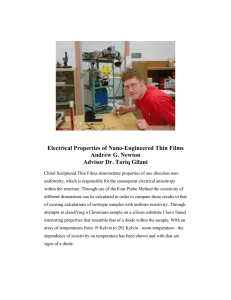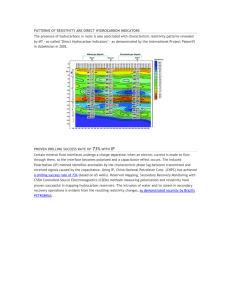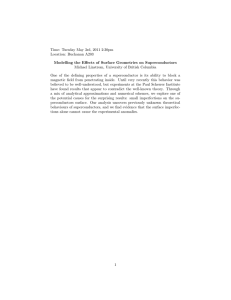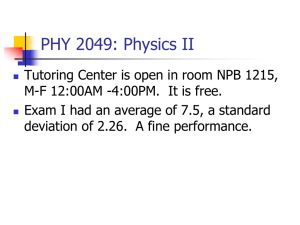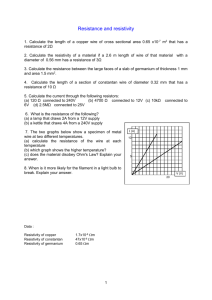Electron Transport Properties of High Temperature Superconductors
advertisement
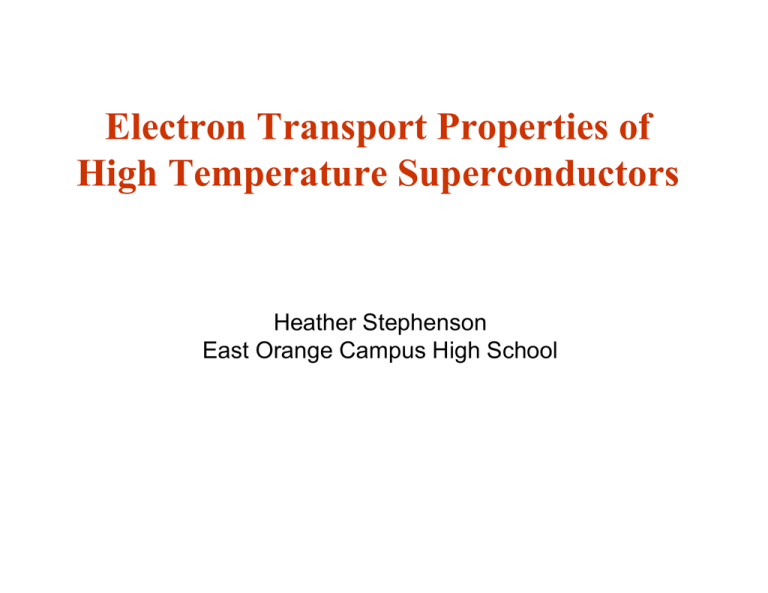
Electron Transport Properties of High Temperature Superconductors Heather Stephenson East Orange Campus High School Introduction (Part 1) History of Superconductors Superconductors are materials in which electrons have no resistance. If started a current will flow forever. The materials were first discovered by the Dutch physicist Heike Kammerlingh Onnes. In 1911, Onnes did an experiment where he passed a current through a pure mercury wire, and he measured its resistance as he slowly lowered the temperature. He cooled the mercury wire to 4 Kelvin (-425˚F or -269˚C) and the resistance quickly vanished. Mercury entered the superconductive state. Current was flowing through the mercury wire with zero resistance. A year later the current was still flowing without any major energy loss, and it displayed persistent currents because electric current continued to flow without an electric potential driving them. Applications of Superconductivity Superconductors are used in power transmissions, magnets in generators, energy storage devices, particle accelerators, levitated vehicle transportation, rotating machinery, and magnetic separations. Type I Superconductors Type I Superconductors, like mercury, lead, and tin, are sometimes called “soft” superconductors. They are pure metals that have zero electrical resistance below a critical temperature. In the materials the superconductivity is destroyed when a magnetic field (Hc) enters the material. Type II Superconductors Type II Superconductors, like YBCO, are called “hard” superconductors. They are superconducting alloys and compounds, except niobium and vandium. They exhibit higher critical magnetic fields than Type I. In these materials two critical fields exists Hc1 and Hc2 (field at which supreconductivity is destroyed. Introduction (Part 2) Preparation of YBCO To make a 25g of the sample YBCO we weighed and used: 4.235g of Yttrium Oxide; 14.814g of Barium Carbonate; and 8.951g of Copper Oxide. The powders were ground with a mortar and pestle for 40 minutes, until a fine powder of uniform gray color was obtained. After grinding, we put the sample into a “Al2O3 boat” and the sample was heated in a furnace for about seventeen hours at a temperature of 950˚C. Then the furnace is turned off, and the sample is cooled at room temperature for approximately six houts before regrinding and reheating. This process was repeated three times before we tested the sample. To test the sample, we placed the powder in a press and made 1.25 inch diameter pellet. We used a maximum pressure of 39,000 lbs. We pressed the sample multiple times, which gave us a better chance of the pellet not cracking. The pellet was pressed out, and placed it into the “boat”. The “boat”, with the pellet was heated in the furnace overnight at a temperature of 950˚C. After heating and cooled, the pellet is coated four times (front, back, and side) with clear nail polish. After the pellet completely dried, we conducted the experiment. The aluminum metal was placed into the dish, then the pellet was placed on top of the metal, and then the small magnet was placed on top of the pellet. Finally, liquid nitrogen was poured in to the dish to observe the Meissner Effect. This test showed that the samples was superconducting. In order to determine the critical temperature and other properties more detailed experiments were done. Here we discuss the resistivity measurements. Transport Properties of Materials: Metals and Insulators I Pr0.70Ca0.30MnO3 Resistance Under Pressure 5 1 atm 1.6 GPa 2.8 GPa 4.7 GPa 5.7 GPa 6.3 GPa ρ (Ω.cm) Materials can exhibit metallic, insulating or both types of transport. In insulators the resistivity increases as one lowers the temperature. While in metals the resistivity decreases as temperature decreases. In the system shown on the left both insulating and metal phases exist in the same material. In complex oxides an external pressure can modify the structure in a complicated way leading to an insulator to metal transition at a given temperature 10 4 10 3 10 2 10 1 10 0 10 -1 10 -2 10 80 120 160 200 240 280 T (K) Taken from C. Cui and T. A. Tyson Phys. Rev. B in press Transport Properties of Materials: Metals and Insulators II For insulators and metals, resistivity (tendency to reduce electron flow) results from as series of mechanisms 1. Presence of defects in the atomic structure Atoms missing in lattice Impurity atoms present Non-Parallel atomic planes 2. Thermal Motion of Atoms (at high temperature) Insulators ρ = ρ0 eEg/T (resistivity is infinite at T=0) Metal ρ = ρ0 + A T2 + B T9/2 (resistivity is zero at T=0 for no defects) Transport Properties of Materials: Superconductors I Unlike insulators and metals, superconductors have finite resistivity at high temperature which have a complicated form. But below a temperature call the Critical temperature the resistivity vanishes. Electrons form Cooper pairs which behave as bosons which travel in the crystal lattice with zero resistanceeven in the presence of lattice defects. Transport Mechanisms in Superconductors The standard explanation for the attraction between electrons to form Cooper pairs is based on the response of the atoms to the presence of the first electron. The atoms are attracted to the first electron in a pair and begin to collapse around its position (lattice interaction). When the second arrives the atoms are disturbed enough to provide it with a strong attractive force. In a new model the first electron flips the spin of an atom in the lattice and this atom attracts the second electron (spin interaction). Scientific American August 1996 In YBCO the electron are conducted along CuO planes. The resistivity in the direction normal to the planes is much larger than parallel to the planes. Scientific American, September 1995 Experimental Methods: Sample A resistivity sample was prepared from our pressed pellet by cutting it and then polishing it into a rectangular shape by using sand paper. Silver paste was used to attach thin gold wires to the sample. Which were then connected to copper wires. The outer leads were used to run a current of 1mA through the sample and the inner white leads we used to measure the voltage. This was done over a range of temperatures from 80K to ~150K. Experimental Methods: Transport Set-Up Picture show the experimental apparatus used to conduct the measurements. The sample was cooled in a cryostat and a temperature controller was used to move the sample to various temperatures under computer control. A source meter, ran a current through the sample the voltage drop was measured at each temperature. Cryostat Source Meter (I, V) Temperature Controller Resistivity Data Collected 0.6 0.5 Resistivity (Ohm cm) The measured resistivity reveal a clear drop in resistance at ~90 K compared to 92.5 for published results. However, the resistivity above the critical temperature is much higher than published work. Two consecutive scans are shown. Note that the critical temperature is ~90 K and that the resistivity at 160 K is ~ 550 mOhm-cm 0.4 0.3 0.2 0.1 0.0 70 80 90 100 110 120 Temperature (K) 130 140 150 160 Standard Literature Results Compared to our sample as standard sample taken from the literature has a much lower resistivity in the normal state (~ 0.400 mOhm-Cm). Also the critical temperature of the standard is higher (93 K) than our sample (90 K). Phys. Rev. Lett, 58, 1676 (1987). Discussion These measurements reveal that some there was some difference between our sample and the standard. We note that in the normal state the resistivity is due to electron scattering from (1) defects, (2) a vibrating lattice and (3) from impurity phases. The value of resistivity in the normal state is 550/0.4~ 1400 times that of the standard. ρ~ 1/λ, where λ is the average distance between scattering events. Hence the separation between defects in our samples is 1400 times smaller than in the standard. Hence the density of defects is significantly larger than in the standard Note also that the transition temperature is only 3 K lower than the standard. This suggest that the sample is composed of a large non-superconducting phase and a possibly smaller supreconducting phase. Transport in the normal state is low due to the difficult paths that the electron must take. The transport in the normal state is percolative. Summary Percolation Model The sample prepared is composed of multiple components with one superconducting component having a Tc of 90 and a large normal phase. Electrons are forced to take a difficult path thorough the material above Tc producing a high resistivity Acknowledgments This project was supported in part by NSF Grant DMR-0209243
